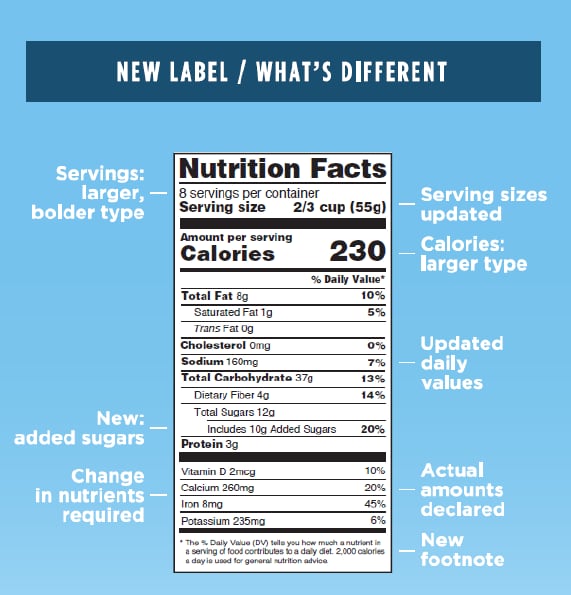Announced by the US Food and Drug Administration on Friday (May 20), a new style of Nutrition Facts Label is being introduced. The first change to the labels in 20 years, it was proposed in 2014 with some alterations made following a public comment period.
Key changes include: a larger type size for calorie content, the introduction of an ‘added sugars’ value, updated list and definitions of nutrients, and the introduction of new serving sizes (see box below for details).
The American Bakers Associations (ABA) said it was making a thorough review of the 943-page document detailing the Nutrition Facts Panel final rule, but flagged up initial areas of concern. These include the difficulty in meeting a two-year deadline for implementing the new labels; the daily reference value and labeling of ‘added sugars’ on pack; and the definition of dietary fiber.
'Extremely disappointed
The association said it was “extremely disappointed” the FDA had failed to incorporate feedback from the baking industry on the compliance timeline.
Manufacturers will have until July 26, 2018 to meet the final requirements, although those with less than $10m in annual food sales have been given an extra year to make the changes.
“A two-year implementation period will be difficult to meet in the best of circumstances and will significantly add to implementation costs for baking companies of all sizes,” said ABA senior vice president for government relations and public affairs Lee Sanders.
Concern over added sugar labeling
Another issue of “great concern” to bakers, said the ABA, was the addition of added sugar labeling declaration and a 10% daily reference value.
“To assure that this change in policy is based on the fully body of scientific evidence, it would have been most appropriate for the National Academy of Science to have conducted an official Daily Reference Intake review before any policy changes were executed,” said Sanders.

With regards to dietary fiber, the ABA said it was unfortunate that the FDA had retained the definition of dietary fiber based on it showing a beneficial physiological effect, rather than a chemical definition “as is the case for most other nutrients.”
But the ABA had some positive comments about the approach to fiber. This included acknowledging that the FDA had determined that scientific evidence supported that cellulose, guar gum, pectin, locust bean gum, and hydroxypropylmethylcellulose showed a beneficial physiological effect to human health.
And the association added it “appreciated” that the FDA had changed the phrase ‘isolated and synthetic’ fiber to ‘isolated or synthetic’ in response to ABA comments, as this helps reflect that fibers that are isolated are not synthetic. The FDA had also included psyllium husk within the definition of dietary fiber.
Consumer education required
Industry body The Grocery Manufacturers Association said the update was timely as diets, eating patterns and consumer preferences have changed dramatically since the Nutrition Facts panel was first introduced.
But it pointed out there was a risk that consumers could be confused by the new label and its “numerous changes” and that consumer education would be needed to ensure people continue to understand how the revised label can be used.
“We look forward to working with FDA and other stakeholders on messages and activities to help consumers understand what the new labels mean,” added GMA chief science officer Dr Leon Bruner.
At a glance: the new-look Nutrition Facts Label

The FDA describes the key changes to the Nutrition Facts Labels, which must be introduced by large food manufacturers by July 26, 2018:
Refreshed design
- Larger type size for Calories, Servings Per Container, and the Serving Size declaration, and bold type for number of calories and the Serving Size to highlight this information
- Manufacturers must declare actual amount, in addition to percent Daily Value of vitamin D, calcium, iron and potassium
- Footnote changing to better explain what percent Daily Value means. It will read: “*The % Daily Value tells you how much a nutrient in a serving of food contributes to a daily diet. 2,000 calories a day is used for general nutrition advice.”
Updated information about nutrition science
- Added sugars, in grams and as percent Daily Value, will be included. FDA said scientific data shows it is difficult to meet nutrient needs while staying within calorie limits if consuming more than 10% of total daily calories from added sugar
- List of nutrients required or permitted to be declared is being updated. Vitamin D and potassium will be required on the label. Calcium and iron will continue to be required
- Vitamins A and C will no longer be required but can be included on a voluntary basis (FDA says this is because vitamins A and C deficiencies in the general population are rare)
- Calories From Fat removed because research shows type of fat is more important than the amount, says FDA. Total Fat, Saturated Fat, and Trans Fat still required on label
- Daily values for nutrients such as sodium, dietary fiber and vitamin D updated based on newer scientific evidence
Updated serving sizes
- FDA says how much people eat and drink has changed since previous serving size requirements were published in 1993
- Changes include: reference amount used to set a serving of ice cream was previously ½ cup but is changing to ⅔ cup; reference for serving of soda is changing from 8 ounces to 12 ounces
- Packages between one and two servings, such as 20-ounce soda or 15-ounce can of soup, required to label calories and other nutrients as one serving because people typically consume it in one sitting
- Manufacturers will have to provide ‘dual column’ labels for products that are larger than a single serving but could be consumed in one sitting or multiple sittings. These will indicate the amount of calories and nutrients on both a ‘per serving’ and ‘per package’ or ‘per unit’ basis. Examples would be a 24-ounce bottle of soda or a pint of ice cream
